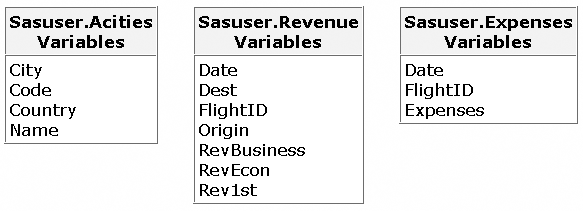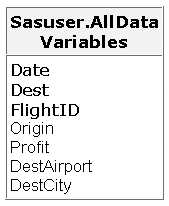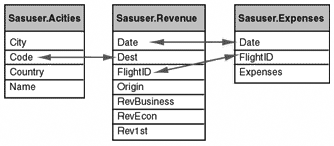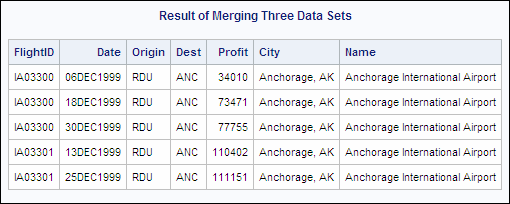Combining Data with the DATA Step Match-Merge
The DATA Step Match-Merge
You
should already know how to merge multiple data sets in the DATA step
when there is a BY variable that is common to each of the input data
sets. When you use the MERGE statement to perform a table lookup operation,
your lookup values must be stored in one or more SAS data sets. This
technique requires that both the base table and the lookup table or
tables be either sorted by or indexed on the BY variable or variables.
You can specify any
number of input data sets in the MERGE statement as long as all input
data sets have a common BY variable. The MERGE statement can combine
data sets of any size. The MERGE statement is capable of returning
multiple values. You can use multiple BY variables to perform lookups
that are dependent on more than one variable. The MERGE statement
returns both matches and nonmatches by default, but you can use DATA
step syntax to return only exact matches or to include only specific
variables from the lookup table.
CAUTION:
Although you can use
the MERGE statement to combine data from sources that have any type
of relationship, this technique might not produce the desired results
when you are working with a many-to-many match. When the data sets
are merged in a DATA step, the observations are matched and combined
sequentially. Once an observation is read, it is never reread. That
is, the DATA step MERGE statement does not create a Cartesian product.
Therefore, the DATA step MERGE statement is probably not an appropriate
technique to use for performing lookup operations when you are working
with a many-to-many match.
Working with Multiple Lookup Tables
Sometimes you might need to combine
data from three or more related SAS data sets in order to create one
new data set. For example, the three data sets listed below all contain
different data about a fictional airline's flights and airports.
Sasuser.Acities contains data about various airports, Sasuser.Revenue
contains data about the revenue generated by various flights, and
Sasuser.Expenses contains data about the expenses incurred by various
flights. The variables in each of these data sets are listed here.
Suppose you want to
create a new data set, named Sasuser.Alldata, that contains data from
each of these three input data sets. As shown below, the Sasuser.Alldata
data set contains the new variable Profit, which is calculated from
the revenue values that are stored in Sasuser.Revenue and the expense
values that are stored in Sasuser.Expenses.
You can specify any
number of input data sets in the MERGE statement as long as all input
data sets have a common BY variable. However, you can see from the
data set variable lists above that these three data sets do not have
one common variable. We will consider a method for performing a match-merge
on these three data sets.
Although the three data
sets Sasuser.Acities, Sasuser.Revenue,
and Sasuser.Expenses do not have a common BY variable, there are several
variables that are common to two of the three data sets. As shown
below, Date and FlightID are both common to Revenue and Expenses.
The variable Code in the Acities data set and the variable Dest in
the Revenue data set, while named differently, contain the same data
with the same type and length.
Notice that Code in
Acities and Dest in Revenue are listed as corresponding to one another
even though they have different names. When you are looking for common
variables between data sets, the variable names are not important
since they can be changed with the RENAME= option in the MERGE statement.
Instead, you should look for variables that record the same information
and that have the same type in each input data set. Common variables
do not need to have the same length, although you should remember
that the length of the variable in the first-listed data set will
determine the length of the variable in the output data set.
Note: Any variables that have the
same name in multiple data sets in the MERGE statement must also have
the same type. If any variables in different input data sets have
identical names but do not have identical types, ERROR and WARNING
messages are written to the SAS log, and the match-merge fails.
In this case, both Code
in Acities and Dest in Revenue record the three-letter abbreviation
of an airport.
Tip
You can use PROC CONTENTS
to view information about variables such as type, length, and description.
Since there are variables
that are common to two different pairs of the three data sets shown
above, you can combine these data sets into one data set by using
the MERGE statement in two subsequent DATA steps. That is, you can
perform one match-merge on two of the data sets to create one new
data set that combines data from both. Then you can perform another
match-merge on the new data set and the remaining original data set.
Consider the following example.
Example
In the following program,
both Sasuser.Expenses and Sasuser.Revenue are sorted by FlightID and
Date and are placed into temporary data sets in preparation for the
merge. Then these two sorted data sets are merged in a DATA step that
creates a temporary output data set named Revexpns. In order to reduce
the total number of variables in the output data set, a new variable
named Profit is created, and the variables that are used to create
Profit are dropped from Revexpns.
proc sort data=sasuser.expenses out=expenses; by flightid date; run; proc sort data=sasuser.revenue out=revenue; by flightid date; run; data revexpns (drop=rev1st revbusiness revecon expenses); merge expenses(in=e) revenue(in=r); by flightid date; if e and r; Profit=sum(rev1st, revbusiness, revecon, -expenses); run;
Note: The use of the temporary
IN= variables E and R in the IF statement above ensures that only
observations that contain data from each of the two input data sets
are included in the output data set.
In the following program,
the output data set named Revexpns is sorted by Dest. Sasuser.Actities
is sorted by Code and is placed in a temporary data set. Remember
that Dest and Code are corresponding variables even though they have
different names.
The sorted data sets
are then merged in a DATA step. Since two data sets must have at least
one variable that matches exactly in order to be merged, the RENAME=
option renames Code to Dest in the output data set. The DATA step
merges Revexpns and Acities into a new output data set named Alldata.
proc sort data=revexpns; by dest; run; proc sort data=sasuser.acities out=acities; by code; run; data sasuser.alldata; merge revexpns(in=r) acities (in=a rename=(code=dest) keep=city name code); by dest; if r and a; run; proc print data=sasuser.alldata(obs=5) noobs; title 'Result of Merging Three Data Sets'; format Date date9.; run;
The PROC PRINT step
prints the first five observations in the Sasuser.Alldata data set
that is created in this example, as shown here.
..................Content has been hidden....................
You can't read the all page of ebook, please click here login for view all page.




